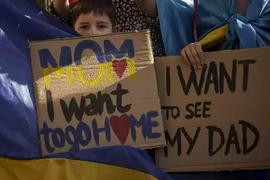The Azerbaijan Red Crescent Society dispatched on Tuesday a humanitarian aid convoy consisting of 40 tons of flour products from Baku to Aghdam district in the Karabakh (Garabagh) region.
The humanitarian aid is destined for the Armenian residents of the Karabakh region of Azerbaijan. From Aghdam, the flour products in two trucks will be supplied to the city of Khankendi, via the Aghdam-Khankendi road.
On August 21, a statement in accordance with the decision of the Management Board of the Azerbaijan Red Crescent Society was signed, President of the Azerbaijan Red Crescent Society Novruz Aslan told reporters, as per Azerbaijani media.
“According to the philosophy of our statement, it is to help every person, regardless of race, religion, or nationality … The management staff of the Red Crescent Society, including our volunteers, will move towards the Aghdam-Khankendi road,” he added.
Aslan said that the initial phase of the humanitarian aid could pave the way for further assistance operations in the future.
“We hope that this step will be positively received by the Armenians living in Khankendi and the international community. If we can carry out the evaluation process in the future, we will be able to deliver other products they need,” he said.
The proposal to use the Aghdam-Khankendi road for goods supplies to the Karabakh region was put forward by Azerbaijani authorities, after multiple illegal shipments were uncovered on the Lachin road – the route connecting the Karabakh region of Azerbaijan with Armenia.
However, the Armenians in the Karabakh region and Yerevan turned down the proposal insisting on the use of the Lachin road, while simultaneously blocking the Aghdam-Khankendi road.
In July, President Ilham Aliyev said the so-called “leadership” of Armenians in the Karabakh region had deliberately installed concrete blocks on the Aghdam-Asgaran portion of the Aghdam-Khankendi road.
“When you said, ‘Why do products have to be shipped from another country? After all, Karabakh [Garabagh] is Azerbaijan.’ Right? It is, isn’t it? Doesn’t everyone recognize it as such? Everyone recognizes it. Does anyone say it is not? No! And why should goods be delivered from another country? This is illogical,” Aliyev said.
Nearly 25,000 Armenians reside in certain parts of the Karabakh region, monitored by a temporary Russian peacekeeping mission. Shortly after the war, the government of Azerbaijan voiced its readiness to reintegrate these people into Azerbaijani society in line with the Constitution and laws of Azerbaijan.
On March 1, officials from Azerbaijan met with the representatives of Armenians residing in the Karabakh region. During the meeting, preliminary discussions were held on their reintegration into the Azerbaijani society. In late March, the Azerbaijani authorities invited the representatives of Karabakh Armenians to Baku for a second meeting.
However, a group of separatists in the Karabakh region meddled to derail the process. They have been seeking a so-called status for the region’s Armenian residents, demanding “independence” from Azerbaijan.
In the meantime, the Armenian separatists in the Karabakh region, as well as the government of Armenia and its foreign allies have been misleading the international community with reports about a so-called “blockade” in the Karabakh region. They are convinced that the authorities of Azerbaijan have been restricting the movement between the region and Armenia on the Lachin road, which has been widely used for military cargo deliveries from Armenia to the separatists in the Karabakh region.
However, daily reports from the road testified to its availability for humanitarian movements, including aids by the Russian peacekeepers and the International Committee of the Red Cross.
On April 23, Baku installed a border checkpoint on the road to prevent its illegal use. Since then, hundreds of Armenian origin people traveled between Armenia and the Karabakh region using the control point. Their movement is not limited by the employees of the State Border Service and State Customs Committee, except for document control procedures.







 President Ilham Aliyev shed light on the evolving contours of the peace process with Armenia during an international conference in Baku this week. ...
President Ilham Aliyev shed light on the evolving contours of the peace process with Armenia during an international conference in Baku this week. ...
 Azerbaijan and Armenia started the process of demarcation of their border on Tuesday, with the installation of the first border markers based on ge...
Azerbaijan and Armenia started the process of demarcation of their border on Tuesday, with the installation of the first border markers based on ge...
 Iranian President Ebrahim Raisi expressed Tehran’s readiness to participate in significant development projects in Sri Lanka during the inauguratio...
Iranian President Ebrahim Raisi expressed Tehran’s readiness to participate in significant development projects in Sri Lanka during the inauguratio...
 As the conflict between Ukraine and Russia escalates, the strategic importance of Kharkiv, Ukraine's second-largest city, has come sharply into focus.
As the conflict between Ukraine and Russia escalates, the strategic importance of Kharkiv, Ukraine's second-largest city, has come sharply into focus.
 Iran and Pakistan have signed eight cooperation documents in various fields, and agreed to strengthen ties to fight terrorism in the region.
Iran and Pakistan have signed eight cooperation documents in various fields, and agreed to strengthen ties to fight terrorism in the region.



